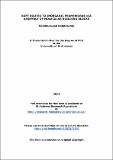Files in this item
Soft routes to inorganic frameworks via assembly of molecular building blocks
Item metadata
| dc.contributor.advisor | Bruce, Peter G. | |
| dc.contributor.author | Kandasamy, Balamurugan | |
| dc.coverage.spatial | [10], 223 | en_US |
| dc.date.accessioned | 2012-09-22T17:38:56Z | |
| dc.date.available | 2012-09-22T17:38:56Z | |
| dc.date.issued | 2012 | |
| dc.identifier | uk.bl.ethos.556418 | |
| dc.identifier.uri | https://hdl.handle.net/10023/3120 | |
| dc.description.abstract | The assembly of mononuclear and polynuclear molecular building blocks has been investigated as a route to extended metal oxide structures. Various [MX[subscript(y)]]ⁿ⁻ (X = Cl, OMe, OH) and [(RO)M’M₅O₁₈]³⁻ (R = MeO, M’ = Sn, M = W) building blocks have been synthesised. Controlled hydrolysis has been explored for transition and main group metal hexahalides [MCl₆]ⁿ⁻ M=Ti, Sn using ¹⁷O enriched water. An attempted synthesis of [Me₃NCH₂Ph] [Sn(OMe)₆] gave the dinuclear product [Me₃NCH₂Ph] [Sn₂(OMe)₉]. Variable temperature ¹H NMR studies revealed exchange between terminal and bridging alkoxides and the limiting spectrum is consistent with solid state structure. 2,6-lutidinium hydrochloride was synthesised and used to chlorinate the metal alkoxides {M(OR)[subscript(n)]} (M = Nb). A route to monochloro niobium alkoxide {NbCl(OMe)₄} was developed and variable temperature ¹H NMR spectroscopy studies of {NbCl(OMe)₄} in different solvents revealed exchange between bridging and terminal alkoxides and also suggested the presence of different structural isomers in solution. A novel heterometallic Lindqvist type of POM containing Sn has been successfully synthesised by using controlled hydrolytic aggregation. A mixture of (TBA)₂WO₄, WO(OMe)₄ and {Sn(O[superscript(t)] Bu)₄} was partially hydrolysed in a non-aqueous solvent to give (TBA)₃[(MeO)SnW₅O₁₈] (1). ¹¹⁹Sn NMR INEPT and selective tin decoupled proton NMR experiments have been carried out to determine the axial and equatorial ²J {¹¹⁹Sn*¹⁸³W} coupling constants and to estimate ³J{¹¹⁹Sn¹H} and ³J{¹¹⁷Sn¹H} coupling constants. The electrochemistry of (1) was studied by cyclic voltammetry (CV), and was shown to undergo a reversible one electron reduction close to the solvent limit. Hydrolysis of [(MeO)SnW₅O₁₈]³⁻ produced [(OH)SnW₅O₁₈]³⁻ (2) which is stable in the solid state but in solution undergoes a condensation reaction to give [(µ- O)(SnW₅O₁₈)₂]⁶⁻ (3). The chloro stannotungstate [ClSnW₅O₁₈]³⁻ (4) was also obtained during the synthesis of (1) and (2). Compounds (2) and (4) are crystallographically isostructural and Sn hetero site was disordered over all six metal positions in both anions. The redox properties of (4) were studied by CV and showed an irreversible reduction peak at -1.67 V. Compound (4) is stable in air and did not react with H₂O or PhOH but did react with MeOH or NaOMe to give (1). It also reacted with diisopropylamine (DIPA) to produce the H-bonded aggregate [(Prⁱ₂NH₂)₂(µ-O)(SnW₅O₁₈)₂]⁴⁻. The adduct structure is related to a recently characterised titanium analogue [(µ-O)(TiW₅O₁₈H)₂]⁴⁻ , which forms the H-bonded THF adduct [(µ-O)(TiW₅O₁₈H)₂(THF)]⁴⁻ . 2D-¹H EXSY NMR studies of the mixtures of (1) and MeOH did not show any exchange peaks between (1) and methanol which demonstrates that exchange is slow but reactivity studies of (1) have been carried out with various alcohols and phenols to give substituted products. Sterically smaller alkyl groups gave trans disordered structures, but no disorder is present in structures of anion with bulkier aliphatic alkoxide and aryloxide groups. Hydrogen bonding was observed between the POM cage and pendant phenolic OH groups All the alkyl and aryloxido derivatives have been characterised by single crystal X-Ray diffraction, ¹H and multinuclear NMR spectroscopy, infrared spectroscopy and CHN analysis. Preliminary studies to explore the immobilisation of metal alkoxides [Ti(OPrⁱ )₄] and (1) on ~30% OH functionalised Si(111) surfaces have been carried out. The attempted covalent immobilisation of (1) to Si(111) surfaces appeared to be successful from Atomic Force Microscopy (AFM) measurements. | en_US |
| dc.language.iso | en | en_US |
| dc.publisher | University of St Andrews | |
| dc.subject.lcc | QD181.O1K2 | en_US |
| dc.subject.lcsh | Metallic oxides--Synthesis | en_US |
| dc.subject.lcsh | Polyoxometalates | en_US |
| dc.subject.lcsh | Chemical processes | en_US |
| dc.title | Soft routes to inorganic frameworks via assembly of molecular building blocks | en_US |
| dc.type | Thesis | en_US |
| dc.type.qualificationlevel | Doctoral | en_US |
| dc.type.qualificationname | PhD Doctor of Philosophy | en_US |
| dc.publisher.institution | The University of St Andrews | en_US |
This item appears in the following Collection(s)
Items in the St Andrews Research Repository are protected by copyright, with all rights reserved, unless otherwise indicated.

